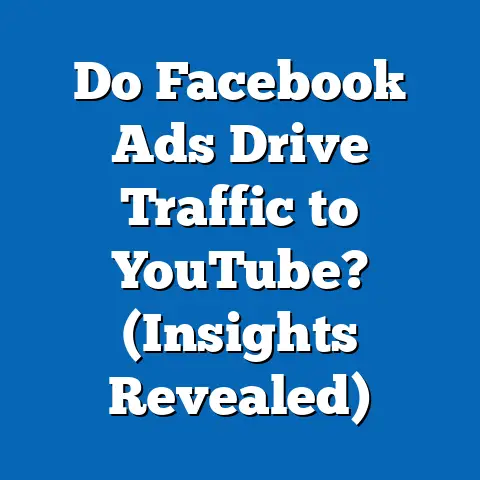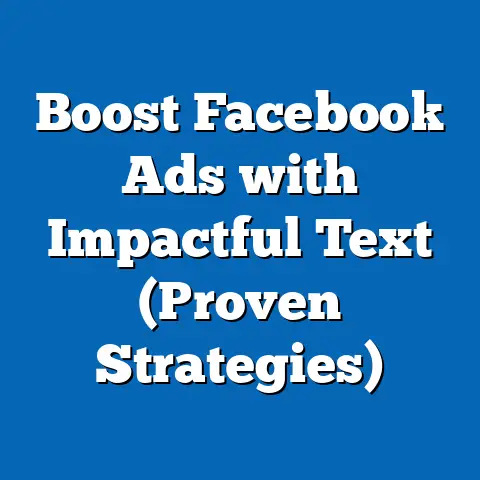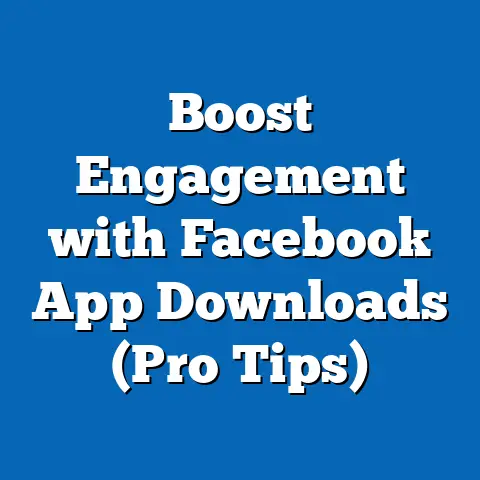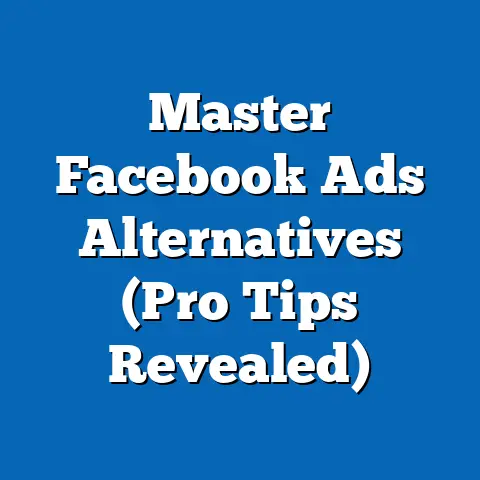Fix Instagram Preview Issues in Facebook Ads (Expert Tips)
Social media advertising has transformed the digital marketing landscape, with platforms like Instagram and Facebook leading the charge. As businesses increasingly rely on these platforms to reach targeted audiences, the seamless integration of ads across both networks—managed through Meta’s Ads Manager—has become critical. However, one persistent challenge for advertisers is ensuring that Instagram previews display correctly when running cross-platform campaigns via Facebook Ads.
This issue, often rooted in technical glitches, creative mismatches, or platform-specific requirements, can significantly impact campaign performance. According to a 2022 report by Hootsuite, 58% of marketers cited visual consistency across platforms as a top concern when managing multi-platform campaigns. With over 1 billion monthly active users on Instagram and 2.9 billion on Facebook (Statista, 2023), resolving preview issues is not just a technical fix—it’s a business imperative.
Section 1: Upgrades in Meta’s Advertising Ecosystem
1.1 Recent Updates to Facebook Ads Manager and Instagram Integration
Meta has continuously evolved its advertising tools to streamline cross-platform campaigns, with significant updates rolled out in 2022 and 2023. One major upgrade is the enhanced Ads Manager interface, which now offers more granular control over how ads render on Instagram and Facebook. According to Meta’s official changelog (2023), the updated preview tool allows advertisers to simulate ad displays across placements, including Instagram Feed, Stories, and Reels, directly within the Ads Manager.
Additionally, Meta introduced AI-driven creative optimization features in late 2022, designed to automatically adjust visuals and text for platform-specific formats. A report by Social Media Today (2023) noted that 67% of advertisers using these tools reported a 20% reduction in manual adjustments for cross-platform ads. This is a significant leap from 2021, when only 45% of marketers felt confident in their ability to manage multi-platform creative assets, per eMarketer data.
Despite these advancements, preview discrepancies persist, often due to differences in aspect ratios, character limits, or unsupported features between platforms. For instance, Instagram Stories ads require a 9:16 vertical format, while Facebook Feed ads often perform better in a 1:1 square format. These nuances highlight the need for advertisers to stay updated on platform-specific requirements.
1.2 Key Statistics on Social Media Advertising Growth
The growth of social media advertising underscores why resolving preview issues is critical. According to Statista (2023), global social media ad spending reached $226 billion in 2022, a 17% increase from 2021, with projections to hit $262 billion by 2024. Instagram alone accounts for 28.7% of Meta’s ad revenue, generating approximately $43 billion in 2022 (Insider Intelligence, 2023).
Moreover, a 2023 survey by HubSpot revealed that 79% of marketers consider Instagram the most effective platform for visual storytelling, compared to 65% for Facebook. This preference for Instagram’s visual-first approach makes preview accuracy non-negotiable—misaligned visuals can deter engagement and reduce return on ad spend (ROAS). Historical data from 2019 shows that only 52% of marketers prioritized Instagram for visual ads, indicating a sharp upward trend in its importance over just four years.
1.3 Demographic Trends in Platform Usage
Understanding the demographics of Instagram and Facebook users provides context for why ad previews must cater to specific audiences. Instagram skews younger, with 71% of its U.S. users aged 18-29, according to Pew Research Center (2023). In contrast, Facebook has a broader demographic spread, with 67% of U.S. adults aged 30-49 and 58% aged 50-64 active on the platform.
These demographic differences influence creative preferences. For example, Instagram’s younger audience responds better to trendy, fast-paced content like Reels, which saw a 220% increase in engagement among Gen Z users in 2022 (Hootsuite, 2023). Meanwhile, Facebook’s older demographic often engages more with detailed captions and static images. Preview issues that fail to account for these nuances—such as cropped text or distorted visuals—can alienate key segments of the audience.
1.4 Trends in Cross-Platform Advertising Challenges
Cross-platform advertising, while efficient, remains a complex endeavor. A 2023 report by Forrester found that 62% of digital marketers struggle with maintaining brand consistency across Meta’s platforms, up from 54% in 2020. Preview errors are a leading cause, with 48% of advertisers reporting issues like mismatched thumbnails or unsupported media formats when ads are shared between Facebook and Instagram.
Historically, these challenges were less pronounced. In 2018, only 35% of marketers cited cross-platform consistency as a concern, per a Marketing Land survey. The rise in reported issues correlates with the growing complexity of ad formats—Instagram now supports over 10 placement types, compared to just 5 in 2018. This evolution demands greater attention to detail in ad setup and preview validation.
Section 2: Understanding Instagram Preview Issues in Facebook Ads
2.1 What Are Instagram Preview Issues?
Instagram preview issues occur when an ad created in Facebook Ads Manager does not display correctly in the preview tool for Instagram placements or, worse, when it goes live. Common problems include cropped images, distorted videos, missing call-to-action (CTA) buttons, or text overlays that violate Instagram’s guidelines. These discrepancies can lead to reduced click-through rates (CTR) and higher cost-per-click (CPC), as the ad fails to resonate with the intended audience.
A 2022 study by AdEspresso found that ads with visual errors on Instagram had a 15% lower CTR compared to properly formatted ads. Given that Instagram’s average CTR for ads is 0.98% (WordStream, 2023), even a small drop can significantly impact campaign performance.
2.2 Common Causes of Preview Discrepancies
Several factors contribute to preview issues, often tied to platform-specific requirements or user error. First, aspect ratio mismatches are a frequent culprit—Instagram Feed ads require a 1.91:1 to 4:5 ratio, while Stories demand a strict 9:16 format. Failing to upload assets in the correct dimensions can result in automatic cropping or black bars, which look unprofessional.
Second, Instagram imposes stricter text limits than Facebook. For instance, primary text on Instagram ads is capped at 125 characters for optimal visibility, whereas Facebook allows up to 40 characters in headlines alone. Ads Manager may not always flag these discrepancies in previews, leading to truncated messaging.
Third, unsupported features can cause errors. For example, Instagram does not support certain interactive elements like event responses or lead forms in the same way Facebook does. A 2023 report by Socialbakers noted that 39% of preview issues stemmed from advertisers attempting to use unsupported formats across platforms.
2.3 Impact on Campaign Performance
The consequences of preview issues extend beyond aesthetics. According to a 2023 analysis by Sprout Social, 54% of Instagram users are less likely to engage with ads that appear distorted or poorly formatted. This disengagement translates to wasted ad spend—Meta’s own data indicates that campaigns with visual errors see a 25% higher cost-per-impression (CPM) on average.
Historically, the tolerance for such errors was higher. In 2017, only 38% of users reported disengaging from poorly formatted ads, per a Nielsen study. The shift reflects growing user expectations for polished, platform-native content, making preview accuracy more critical than ever.
Section 3: Expert Tips to Fix Instagram Preview Issues
3.1 Tip 1: Use Meta’s Preview and Diagnostic Tools
Meta’s Ads Manager includes built-in preview and diagnostic tools to identify potential issues before an ad goes live. Within the ad creation interface, advertisers can toggle between Facebook and Instagram placements to see how the ad renders in each format. Meta also offers a “Creative Hub” for mocking up ads and testing visuals across platforms.
To maximize these tools, ensure you preview the ad on both desktop and mobile views, as 93% of Instagram users access the platform via mobile (Statista, 2023). If discrepancies appear, use the diagnostic report to pinpoint issues like unsupported media types or text violations. A 2022 survey by Digiday found that advertisers who regularly used preview tools reported a 30% lower incidence of visual errors.
3.2 Tip 2: Adhere to Platform-Specific Creative Guidelines
Each placement on Instagram and Facebook has unique creative requirements, and adhering to them is non-negotiable. For Instagram Feed ads, use images with a resolution of at least 1080×1080 pixels to avoid pixelation. For Stories, stick to the 9:16 ratio and keep critical content within the safe zone (top 14% and bottom 20% of the screen are often obscured by UI elements).
3.3 Tip 3: Test Multiple Creative Variations
Creating multiple versions of an ad ensures you have backups if one format fails to render correctly. Meta’s Dynamic Creative tool allows advertisers to upload various images, headlines, and CTAs, automatically testing combinations for optimal performance. A 2023 study by AdRoll found that campaigns using dynamic creative saw a 22% higher engagement rate on Instagram compared to static ads.
When testing variations, prioritize platform-specific optimizations. For example, vertical videos perform 35% better on Instagram Stories than horizontal ones (Hootsuite, 2023). Preview each variation in Ads Manager to catch discrepancies early.
3.4 Tip 4: Update Assets for Cross-Platform Compatibility
To minimize preview issues, design assets with cross-platform compatibility in mind. Start with a base creative in a 1:1 ratio (square), which works well on both Facebook Feed and Instagram Feed, then create variations for Stories or Reels. Use tools like Figma or Crello to batch-resize images and videos for different placements.
Additionally, avoid heavy text overlays—Instagram limits text to 20% of an image’s surface area in most placements. A 2022 report by Social Media Examiner noted that ads violating this rule were 18% more likely to encounter preview errors or disapprovals.
3.5 Tip 5: Monitor and Adjust Post-Launch
Even with thorough pre-launch testing, issues can arise after an ad goes live. Regularly monitor performance metrics in Ads Manager, focusing on engagement rates and CPM. If an Instagram placement underperforms compared to Facebook—say, a CTR of 0.5% versus 1.2%—check the live ad for visual errors.
Meta’s Ad Delivery Insights can also flag rendering issues post-launch. A 2023 case study by MarketingProfs found that advertisers who adjusted creatives within 24 hours of identifying errors recovered 15% of lost engagement on average. Act quickly to pause underperforming placements and upload corrected assets.
Section 4: Historical Context and Comparative Analysis
4.1 Evolution of Cross-Platform Ad Challenges
Cross-platform advertising challenges have evolved alongside the platforms themselves. In 2015, when Instagram ads were first integrated into Facebook Ads Manager, only 28% of marketers reported preview issues, per a MarketingSherpa survey. At the time, ad formats were simpler, with fewer placement options and less stringent guidelines.
By 2020, as Instagram introduced Stories and IGTV ads, the complexity increased, and 49% of advertisers cited preview discrepancies as a barrier (eMarketer, 2020). Today, with over a dozen placement types and dynamic formats like Reels, the challenge has intensified, affecting 62% of marketers (Forrester, 2023). This trend reflects the growing need for technical expertise in managing Meta’s ad ecosystem.
4.2 Demographic Shifts and Their Impact
Demographic shifts have also influenced how preview issues impact campaigns. In 2016, Instagram’s user base was 59% aged 18-29 in the U.S. (Pew Research, 2016), a group more forgiving of minor visual errors. By 2023, while the core demographic remains young, the platform has attracted older users, with 44% of U.S. users now aged 30-49 (Pew Research, 2023).
This broadening audience demands higher-quality, tailored content. Older users, accustomed to Facebook’s polished ad formats, are less tolerant of errors, with 61% reporting they skip ads with visual issues, compared to 47% of Gen Z users (Sprout Social, 2023). Advertisers must account for these varying expectations when troubleshooting previews.
Section 5: Data Visualization Description
To illustrate the impact of preview issues, imagine a bar chart titled “Engagement Drop Due to Visual Errors on Instagram Ads (2022-2023).” The X-axis lists categories like “Cropped Images,” “Distorted Videos,” and “Text Violations,” while the Y-axis shows the percentage drop in CTR. Data sourced from AdEspresso (2023) reveals a 15% CTR drop for cropped images, 18% for distorted videos, and 12% for text violations.
A second line graph, “Ad Spend Growth on Instagram vs. Preview Error Reports (2018-2023),” overlays two trends using Statista and Forrester data. The blue line shows ad spend rising from $8 billion in 2018 to $43 billion in 2022, while the red line tracks preview error reports increasing from 35% to 62% of marketers over the same period. These visuals underscore the correlation between rising investment and the urgency to resolve technical challenges.
Section 6: Broader Implications and Future Trends
6.1 Implications for Digital Marketing Strategies
Instagram preview issues in Facebook Ads are more than a technical annoyance—they reflect broader challenges in cross-platform advertising. As businesses allocate larger budgets to social media ads (projected to grow 15% annually through 2027, per Insider Intelligence), ensuring visual consistency is critical to maximizing ROAS. Failure to address these issues risks alienating audiences and inflating costs, with poorly formatted ads costing 25% more per impression (Meta, 2023).
Moreover, preview errors can damage brand perception. A 2023 survey by Edelman found that 68% of consumers view poorly executed ads as a sign of unprofessionalism, particularly among younger demographics on Instagram. Brands must prioritize technical accuracy to maintain trust and engagement.
6.2 Future Trends in Ad Tech Solutions
Looking ahead, advancements in ad tech promise to mitigate preview issues. Meta is reportedly developing enhanced AI tools for real-time creative validation, expected to roll out in 2024, which could reduce manual errors by 50% (Social Media Today, 2023). Additionally, third-party platforms like Canva and Sprout Social are integrating Meta’s ad specs into their design tools, making compliance easier for small businesses.
However, as ad formats continue to evolve—think augmented reality (AR) ads or interactive Reels—new challenges will emerge. Advertisers must stay agile, leveraging both Meta’s resources and external tools to keep pace with platform updates. The stakes are high: with Instagram’s ad revenue projected to reach $60 billion by 2025 (Statista, 2023), mastering cross-platform execution will separate successful campaigns from costly missteps.
Conclusion: A Call to Action for Advertisers
Instagram preview issues in Facebook Ads are a solvable challenge, but they require proactive effort and attention to detail. By leveraging Meta’s tools, adhering to creative guidelines, testing variations, and monitoring performance, advertisers can minimize errors and maximize impact. The data is clear—visual consistency drives engagement, with properly formatted ads achieving up to 22% higher CTRs (AdRoll, 2023).
As social media advertising continues to grow, resolving these technical hurdles is not just about fixing previews—it’s about building trust, optimizing spend, and meeting the expectations of diverse audiences. Whether you’re a small business or a global brand, the time to refine your cross-platform strategy is now. Stay informed, test rigorously, and adapt to the ever-changing digital landscape to ensure your ads shine on both Instagram and Facebook.






